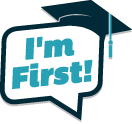This article was originally written for FirstGenerationStudent.com, now a part of ImFirst.org.
Almost everyone is a member of at least one social network, but how much attention do you give to your posts, your profile or the photos you share? What do your privacy settings look like? Have you ever stopped and wondered who might have access to your information? Even with the best privacy settings enabled, do you trust your connections to not share your content with others?
Don’t be scared—be smart. It’s easy to get frightened away from social media, but using these tools wisely will take away fear. Social media is an incredible resource with extraordinary powers that allow us to share content, ask questions, network around the world (or around campus), perform research, make new friends and follow breaking news, all from our computers or mobile devices.
As of June 2013, Facebook has 1.15 billion active monthly users—an incredible number that continues to grow. How do you use Facebook? Are you connected with your friends and family? That’s what most people use Facebook for, but they also follow or ‘like’ brands and public figures (such as musicians, actors, authors and artists). Many users of Facebook don’t intend for their content to be made public, just shared within their own network—a smart strategy. Just make sure that your privacy settings reflect your preferences with each new post.
Twitter has over 233 million active users as Of June 2013. How do you use Twitter? Do you tweet often? The major difference between Facebook and Twitter is the fact that Twitter should always be public. Yes, you can protect your tweets, but that takes the social out of the social network. Twitter is all about sharing information in 140 characters or less through tweeting photos, links to interesting stories, news or personal updates that are suitable for public viewing.
Looking to grow your audience or add followers? By using proper hashtags and connecting with the right Twitter users, you can amplify your message, leading to more reactions, more questions and more sharing. Allow people to follow you on Twitter and keep it fun and entertaining; but, know your audience and follow those that follow you for richer content and a better exchange of ideas and comments. Be sure to follow interesting people within your field of study.
Have you created your resume? If you’re headed to college, then it’s time to create a professional resume to start showing the world what you’ve accomplished so far … and to show off the skills you’re gaining at that internship. It’s also time to create a LinkedIn profile. As of October 2013, LinkedIn had more than 238 million users in over 200 countries.
Recently, LinkedIn launched University Pages, in which many institutions of higher education now have a presence. Now it’s your turn. Create an account, upload a professional photo and showcase your experience. Employers will ask if you’re on LinkedIn.
Blogs
Do you have a blog? Why not? Create a blog and fill it with information and news about your field of study or what interests you the most. The more content you create, the more often your readers will interact with it and share your knowledge via social media. It’s a great way to get discovered by your peers and share information. Remember, don’t judge or condemn other’s points of view. Always be respectful and accept feedback and criticism with respect. (This doesn’t mean you can’t reply.)
General Principles
Finally, it’s important to participate in networking events both online and offline. Appearing offline can help you connect with people and prove that you’re not a robot, but someone who connects with his or her audience. Get to know your followers and those you’re following in person as well as via social media.
As of August 2013, 98 percent of 18 to 24-year-olds already use social media, and each day it becomes more and more popular. I encourage everyone to use social media, but to use it wisely. My philosophy is simple: Don’t post anything you wouldn’t want your grandmother to see. It’s your reputation that is on the line. Remember, there is no erase button on the Internet.
